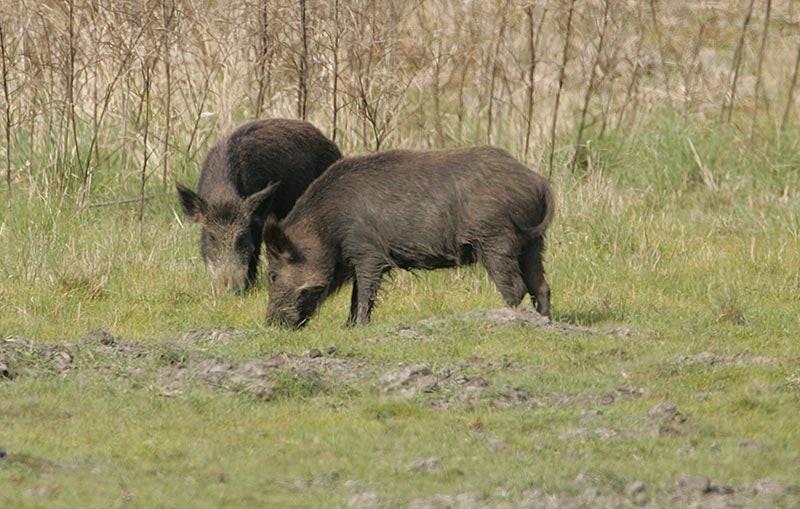Many Alabama farmers, landowners and wildlife managers are fighting a war. This enemy seems to multiply exponentially, damages crops and pastures, competes with native wildlife, and is quite simply the most destructive nuisance animal ever brought to Alabama. This war is against the feral hog.
Able to adapt to almost any habitat type, the feral hog is leaving a path of damage and destruction across Alabama and other parts of the country. Feral hogs compete directly with wildlife for food and habitat. Farmers, landowners, and wildlife managers are quickly learning that winning this war will be no easy task. The feral hog is an intelligent, pressure sensitive, opportunistic omnivore that cannot be controlled by a single method. Only a multi-faceted control program will decrease hog populations due to their extremely high reproductive rates and lack of natural predators. Studies suggest that 80 percent of a population must be removed just to keep the populations from continuing to grow. Control programs for feral hogs must employ multiple methods to be successful, require many man-hours, and can be quite expensive. Control methods include hunting/opportunistic shooting, trapping, hunting with dogs, hunting over bait, hunting at night and advanced control methods.
Hog hunting popularity is at an all-time high and landowners can use this popularity to add to hog removal totals. Some landowners are even setting up commercial hunting operations to make up for funding spent on other control methods. With no closed season and no bag limits, Alabama hunters can harvest hogs year round. Opportunistic shooting of hogs requires always carrying a firearm when on your property. If you want to see hogs on your property, leave the house without a weapon.
Trapping is the most cost effective hog control method, but can be somewhat expensive. Materials for traps can add up quickly and varies with the price of steel. Once constructed, traps allow hogs to be caught while you are not in the field. Proper pre-baiting and strategic baiting of hog traps can lead to entire family groups of hogs -- called sounders -- being caught at one time. The use of motion activated trail cameras can also increase hog trapping success rates. Overall, trapping is the best way to eliminate large numbers of feral hogs without spending hundreds of man-hours in the field.
Hunting with dogs is another important part of a hog control program when used properly. Hog dogs and handlers can quickly catch hogs that have become trap shy or wary of other control methods like hunting. All hogs bayed by dog hunters should be euthanized on site to avoid any accidental escapes or illegal movement of hogs off the property where they were caught.
Hunting over bait and hunting at night are both control methods that require a Wildlife Damage Permit from your local Conservation Enforcement Officer or Wildlife Biologist. Both methods can be effective depending on the habitat types in your area. Hog hunting at night is more effective in row crops or pastures. Remember that a hog’s eyes do not glow at night like those of a deer. This makes finding them with a light more difficult. Monitoring bait piles regularly if increases the success of hunting over bait. Baiting can increase food intake by hogs, which can possibility increase the reproduction in sows. Do not continue to feed hogs if you are not going to have time to hunt them.
Advanced control methods include the use of night vision, thermal imagery, helicopters and radio telemetry equipment. These high-cost techniques are utilized by state and federal agencies conducting hog control or eradication programs, but some landowners have realized spending a few thousand dollars for high-tech gear may be worth their added effectiveness at removing hogs from their property.
Control of feral hogs in Alabama is a time consuming and sometimes expensive proposition. Farmers, landowners, and wildlife managers need to utilize a multi-faceted approach to win the war to control feral hogs and decrease the damage to Alabama’s natural resources. For more information on feral hog control methods contact your local Wildlife and Freshwater Fisheries district office.






